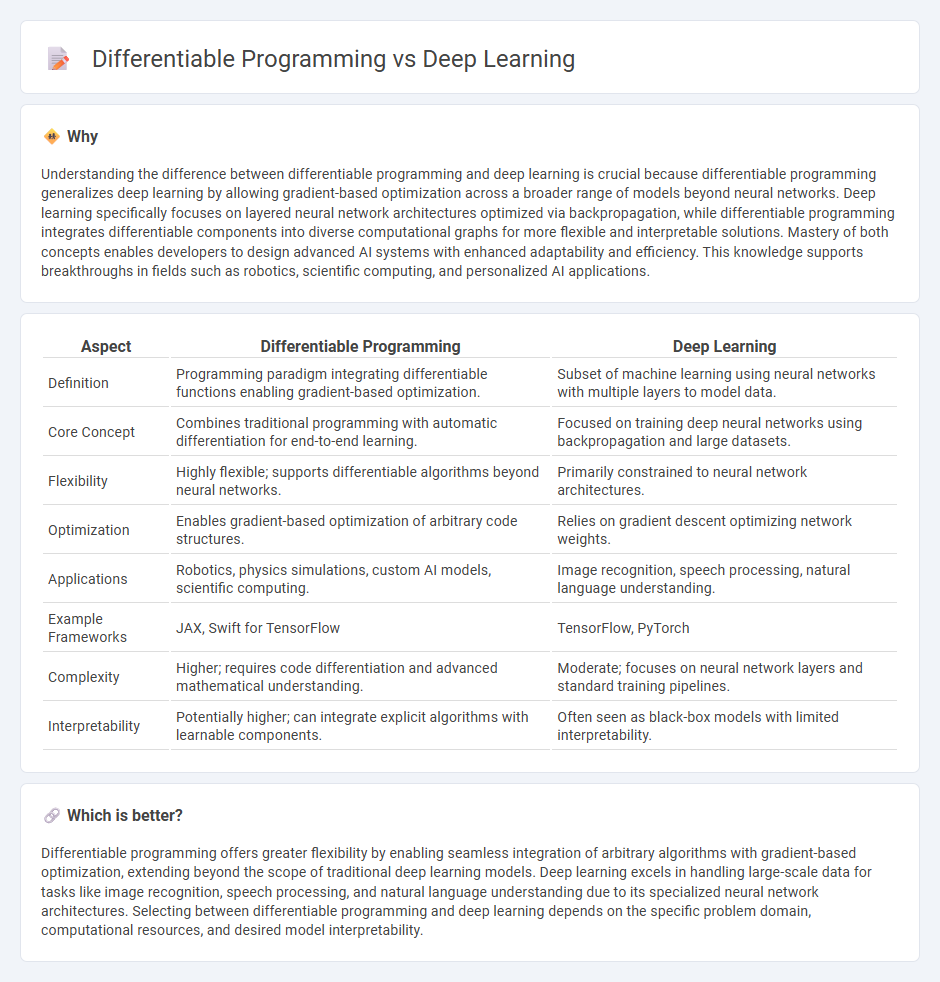
Differentiable programming integrates optimization and gradient-based techniques directly into general-purpose programs, enabling flexible and interpretable model design beyond traditional neural networks. Deep learning specifically utilizes layered neural networks to automatically extract features from large datasets for tasks like image recognition and natural language processing. Explore more to understand how differentiable programming can expand the capabilities of deep learning models.
Why it is important
Understanding the difference between differentiable programming and deep learning is crucial because differentiable programming generalizes deep learning by allowing gradient-based optimization across a broader range of models beyond neural networks. Deep learning specifically focuses on layered neural network architectures optimized via backpropagation, while differentiable programming integrates differentiable components into diverse computational graphs for more flexible and interpretable solutions. Mastery of both concepts enables developers to design advanced AI systems with enhanced adaptability and efficiency. This knowledge supports breakthroughs in fields such as robotics, scientific computing, and personalized AI applications.
Comparison Table
| Aspect | Differentiable Programming | Deep Learning |
|---|---|---|
| Definition | Programming paradigm integrating differentiable functions enabling gradient-based optimization. | Subset of machine learning using neural networks with multiple layers to model data. |
| Core Concept | Combines traditional programming with automatic differentiation for end-to-end learning. | Focused on training deep neural networks using backpropagation and large datasets. |
| Flexibility | Highly flexible; supports differentiable algorithms beyond neural networks. | Primarily constrained to neural network architectures. |
| Optimization | Enables gradient-based optimization of arbitrary code structures. | Relies on gradient descent optimizing network weights. |
| Applications | Robotics, physics simulations, custom AI models, scientific computing. | Image recognition, speech processing, natural language understanding. |
| Example Frameworks | JAX, Swift for TensorFlow | TensorFlow, PyTorch |
| Complexity | Higher; requires code differentiation and advanced mathematical understanding. | Moderate; focuses on neural network layers and standard training pipelines. |
| Interpretability | Potentially higher; can integrate explicit algorithms with learnable components. | Often seen as black-box models with limited interpretability. |
Which is better?
Differentiable programming offers greater flexibility by enabling seamless integration of arbitrary algorithms with gradient-based optimization, extending beyond the scope of traditional deep learning models. Deep learning excels in handling large-scale data for tasks like image recognition, speech processing, and natural language understanding due to its specialized neural network architectures. Selecting between differentiable programming and deep learning depends on the specific problem domain, computational resources, and desired model interpretability.
Connection
Differentiable programming integrates gradient-based optimization techniques with traditional programming, enabling the seamless training of complex models by automatically computing derivatives. Deep learning leverages differentiable programming frameworks like TensorFlow and PyTorch to optimize neural network parameters through backpropagation efficiently. This connection accelerates innovation in AI by combining mathematical differentiation with scalable computational architectures.
Key Terms
Neural Networks
Deep learning leverages neural networks with fixed architectures optimized through backpropagation to model complex patterns in data, whereas differentiable programming extends this by making entire programs differentiable, enabling more flexible and modular neural network designs. Neural networks in differentiable programming benefit from seamless integration with optimization algorithms, enhancing adaptability and learning efficiency across diverse tasks. Explore more to understand how differentiable programming revolutionizes neural network training and applications.
Automatic Differentiation
Deep learning relies heavily on automatic differentiation to optimize neural network parameters efficiently through gradient-based methods, enabling backpropagation and learning from large datasets. Differentiable programming extends this concept by integrating automatic differentiation across a broader range of computational models and programming constructs, allowing more flexible and expressive model designs beyond traditional neural networks. Explore how automatic differentiation powers both paradigms to innovate machine learning and artificial intelligence applications.
End-to-End Optimization
Deep learning relies on neural networks trained through backpropagation to optimize parameters layer-by-layer, focusing on hierarchical feature extraction. Differentiable programming extends this by enabling complex, end-to-end optimization across entire systems composed of differentiable components beyond standard neural networks. Discover how end-to-end differentiable programming revolutionizes model design and optimization strategies.
Source and External Links
What is Deep Learning? - Deep learning is a type of machine learning that uses artificial neural networks to learn from data, inspired by the human brain.
What is deep learning in AI? - Deep learning models are neural networks designed after the human brain, used to process data in complex tasks like image recognition.
Deep learning - Deep learning focuses on utilizing multilayered neural networks for tasks such as classification, regression, and representation learning.
 dowidth.com
dowidth.com